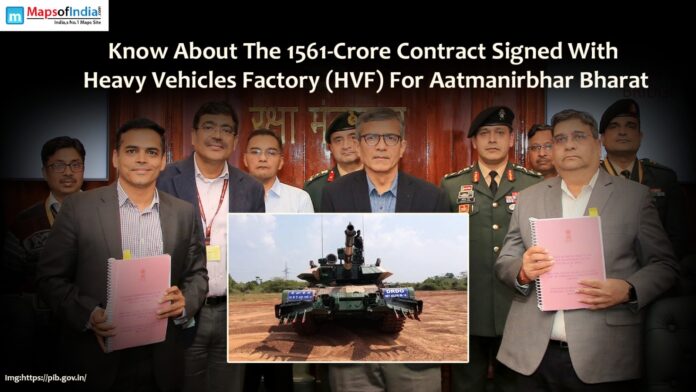Keeping in line with the country’s vision of Aatmanirbhar Bharat or “self-reliant India”, the Indian government has been taking several steps in several sectors that have phased out during different times. Still, one such sector that is always on a diversification path is the defence manufacturing industry. Well, one of the last big contracts that created a bit of a media buzz is that unique Rs 1,561 crore deal with the Heavy Vehicles Factory (HVF) in Tamil Nadu’s Avadi. This step by the Indian government signifies the intention to promote Make in India and strengthen its arsenal through indigenous means.
The Vision of Aatmanirbhar Bharat
Aatmanirbhar Bharat is not simply a slogan; it is a movement to lessen India’s reliance on imports and to help Indigenous industries grow. The programme, launched by Prime Minister Narendra Modi in 2020, is based on five pillars: economy, infrastructure, system, vibrant demography, and demand. This first initiative includes defence manufacturing, which aims to make the country self-sufficient in its defence needs.
India has always been among the top importers of defence equipment. This dependence upon foreign technology and systems has drawn economic dollars out of the USA and become an issue of national security concerns. The Aatmanirbhar Bharat initiative aims to redefine this status quo by promoting local manufacturing and fostering local talent.
Hindustan Aeronautics: Flags of Excellence in Aerospace and Defence Manufacturing
Established in 1965 in Avadi, Tamil Nadu, the Heavy Vehicles Factory (HVF) has been a key pillar of India’s defence manufacturing ecosystem. Under the Ordnance Factory Board, HVF specialises in manufacturing armoured fighting vehicles, such as the iconic Arjun main battle tanks (MBTs) and T-72 and T-90 tanks, the backbone of the Indian Army’s armoured divisions.
The factory has played a central role in defence preparedness and has changed over the years with the changing needs of modern warfare. Through the attention to Indigenous design, production HVF has emerged as a symbol of India’s growing self-reliance in defence technology.
What Does The Rs 1,561 Crore Contract Entail?
The landmark Rs 1,561 crore contract recently inked by the MoD with the Heavy Vehicle Factory (HVF) to procure the MBTs affirms India’s will for indigenisation in the defence manufacturing sector. According to reports, the deal includes investment and transferring many armoured fighting vehicles (AFVs) and related platforms.
Although the deal will aim to improve the operational capabilities of forces, including AVANI advanced tanks and infantry combat vehicles, the capabilities that the hardware under this contract will possess have not yet been disclosed. The agreement will presumably cover retrofits of legacy systems so they match up to modern warfare.
Important Points and Highlightsoft This Deal
-
Enhancing National Security
With indigenous production of armoured vehicles, India will not have to rely on foreign suppliers, enhancing its strategic autonomy. Geopolitics is tearing down global supply chains, making a strong domestic defence manufacturing base imperative.
-
Boosting the Domestic Economy
This contract provides a substantial financial boost for the home defence industry. In addition to offering support to HVF, it creates opportunities for a broad community of suppliers and SMEs to be part of the production process. This creates a ripple effect that drives the economy and creates jobs.
-
Indigenous Innovation
The contract will also likely spur an innovation ecosystem in the domestic defence industry. These indigenously designed/developed systems will be cost-effective and tailored to the country’s operational needs.
-
Export Potential
A robust home manufacturing base can also allow entry to defence exports. In that respect, India is already on the right track, exporting defence equipment to over 75 countries. These contracts lend credibility to Indian defence offerings, thus making them attractive to global buyers.
Challenges
Even though it is, in principle, supposed to provide self-reliance, there are a series of challenges. These include:
- Technology Gaps: However, as the Indian ecosystem matures, there are still gaps that need to be bridged with R&D, especially in advanced technologies.
- Cost Escalation and Delays: Defence projects have faced cost escalation and delays in India that may impede the larger objectives of Aatmanirbhar Bharat.
- Indigenous Tech: Quality Assurance: Indigenous equipment must be manufactured per international quality standards for domestic use and export.
Opportunities
- Involvement of Private Players: Collaborating with private players in defence manufacturing will enhance innovation and efficiency.
- Skill Development: Such initiatives generate opportunities to develop skills in high-end manufacturing sectors.
- Partnerships Around the Globe: Friendly, competitive countries can collaborate with India to contribute critical technologies without compromising India’s vision of self-reliance.
The Road Ahead
The Rs 1,561 crore deal with the HVF is a positive step forward, but it must be seen in a larger picture. The government and the industry will need to come together using the vision of Aatmanirbhar Bharat to translate it into a description of the reality on the ground, helping identify challenges and seize opportunities.
Policy Support
The government has already enacted several policies to promote Indigenous defence manufacturing, including:
- Defence Acquisition Procedure (DAP) 2020: Under this policy, the emphasis was on the ‘Buy Indian’ and ‘Buy and Make Indian’ categories.
- Production-Linked Incentive (PLI) Scheme: Incentives for domestic production in multiple sectors, including defence.
- FDI Liberalisation: 74% in automatic and 100% with government approval: In defence manufacturing, the limit of Foreign Direct Investment (FDI) has been increased to 74% under the automatic route and 100% with government approval.
Technological Advancements
R&D investment is key to closing the technology gaps. Steps such as collaboration by the Defence Research and Development Organisation (DRDO) with private companies and academic institutions can go a long way in facilitating it.
Focus on Exports
India must make its defence products globally competitive to meet its target of $5 billion in defence exports by 2025. This includes enhancing quality, following international standards, and implementing effective marketing.
Conclusion
The contract, signed with HVF for Rs 1,561 crore, is a significant step toward making India self-reliant for defence needs. It is part of the bigger vision of the Aatmanirbhar Bharat initiative and caters to the themes of industrialisation, self-reliance, and national security. Despite the remaining challenges, the potential of this initiative is tremendous. With policy sustainment, strategic investments in R&D, and continued dialogue between public and private sectors, India’s path to establishing its global leadership in defence manufacturing is very much in the offing. The HVF had signed a contract; they are a financial agreement and a milestone towards a robust, Indigenous India.




